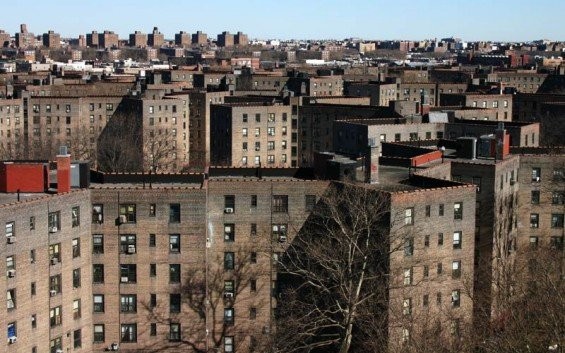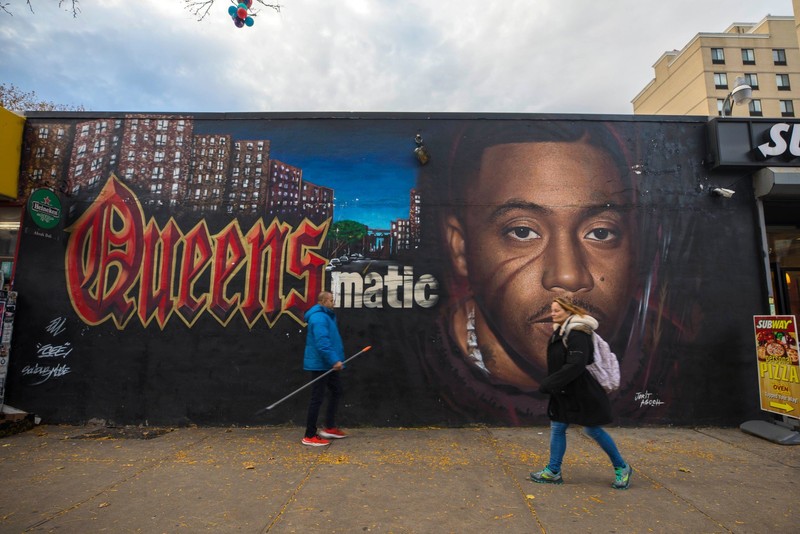Queensbridge Houses
Introduction
Text-to-speech Audio
"Now let me take a trip down memory lane"
"Comin' outta Queensbridge"
--Nas, “Memory Lane (Sittin’ in da Park),” Illmatic (1994)
Situated along the East River in the shadows of the Queensboro Bridge, the 29 brown-brick towers of Queensbridge are the largest public housing project in the United States. Immortalized by the likes of Nas and Mobb Deep, Queensbridge holds an almost mythical place in the cultural landscape of American Hip-Hop. Bleak and violent but with a view of the bright lights of Manhattan, it has become perhaps the most well-known image of a hard-nosed housing project as the crucible for determined rappers. Today, the area around Queensbridge is rapidly gentrifying, yet the Queensbridge apartments and parks remain an affordable if under-maintained home for nearly 7,000 low-income New Yorkers.
Images
Queensbridge under construction--a massive investment in housing the city's low-income residents

A sea of fortress-like towers in America's largest housing project

A mural showing Nas with his iconic Queensbridge roots

The revamped river-walk and Queensbridge park named in honor of longtime resident and activist Elizabeth McQueen

Backstory and Context
Text-to-speech Audio
"You love to hear the story again and again"/"Of how it all got started way back when"/"The monument is right in your face"/"Sit and listen for a while to the name of the place"
--MC Shan, "The Bridge," Down by Law (1987)
Queensbridge Houses opened in 1939 as part of a massive commitment at both the local and national level to improving living conditions in New York. It was unique amongst New York's many public housing complexes in that its cookie-cutter buildings were shaped like large Xs to allow each apartment greater ventilation and daylight. The complex was also ahead of its time in providing numerous recreational and community facilities throughout its scenic riverside location as well as mixed-use spaces like shops and grocery stores that provided the city with rents to maintain the properties. On the downside, the apartments were diminutive and monotonous even by New York standards. Other cost-saving measures like elevators that skipped every-other floor were also implemented.For a decade Queensbridge was one of the only non-segregated housing projects in the country. Eventually in the 1950s higher-income (mostly white) residents were relocated to other developments, leaving a majority of poorer African American and Latino residents. In the 1980s and 90s crime escalated in Queensbridge as Reagan cut federal subsidies for low-income housing and as the crack epidemic hit New York. Nas's song "Destroy and Rebuild" begins by describing Queensbridge as "the world's most largest and notorious projects." It was also during this time that rap and hip-hop began to emerge as musical forms in the parks and public spaces of Queensbridge. In a well-known line, one-time "Bridge" resident MC Shan rapped in 1987, "Hip-hop was set out in the dark/they used to do it in the park."
Recently community members and New York officials have worked to make Queensbridge safer and more livable by revamping public spaces and offering new programs to residents. These efforts have been somewhat successful--barbecues, softball games, and family gatherings stretch throughout the property on warm evenings and in 2016 there was not a single shooting in Queensbridge. New troubles appear to be on the horizon though with the announcement of Amazon's plan to open a massive new location just south of Queensbridge--a move that residents worry will exacerbate a sense of being left behind in a neighborhood where property values now run into the millions but where public investments in public transportation and public housing are lagging.
Sources
Ferre-Sadurni, Luis. The Rise and Fall of New York Public Housing: An Oral History. The New York Times. July 18, 2018. Accessed December 14, 2018. https://www.nytimes.com/interactive/2018/06/25/nyregion/new-york-city-public-housing-history.html.
Giurgiulescu, Anca. Queensbridge, NYC: Inside America’s Largest Public Housing Project. Untapped Cities. July 01, 2013. Accessed December 14, 2018. https://untappedcities.com/2013/07/01/queensbridge-nyc-inside-americas-largest-public-housing-project/.
Frederick, Brendan. Mobb Deep’s Queensbridge Classics. XXLmag. April 13, 2006. Accessed December 14, 2018. https://web.archive.org/web/20081210141845/http://www.xxlmag.com/online/?p=1080.
Kilgannon, Corey. Amazon’s New Neighbor: The Nation’s Largest Housing Project. The New York Times. November 12, 2018. Accessed December 14, 2018. https://www.nytimes.com/2018/11/12/nyregion/amazon-queens-queensbridge-houses.html.
Dwyer, Jim. Six Blocks, 96 Buildings, Zero Shootings: New Recipe at the Queensbridge Houses. The New York Times. January 17, 2017. Accessed December 14, 2018. https://www.nytimes.com/2017/01/19/nyregion/six-blocks-96-buildings-zero-shootings-new-recipe-at-the-queensbridge-houses.html.
Ettelson, Robbie. Unkut.com Presents: The 50 Greatest Queensbridge Rap Songs. Complex. September 30, 2010. Accessed December 14, 2018. https://www.complex.com/music/2010/09/the-50-greatest-queensbridge-rap-songs/the-bridge.
Dwyer, Jim. Queens Crusader Turned the Tide for a Crumbling Park and Its Sea Wall. The New York Times. July 21, 2016. Accessed December 14, 2018. https://www.nytimes.com/2016/07/22/nyregion/queens-crusader-turned-the-tide-for-a-crumbling-park-and-its-sea-wall.html.
Giurgiulescu, Anca. Queensbridge, NYC: Inside America’s Largest Public Housing Project. Untapped Cities. July 01, 2013. Accessed December 14, 2018. https://untappedcities.com/2013/07/01/queensbridge-nyc-inside-americas-largest-public-housing-project/.
Frederick, Brendan. Mobb Deep’s Queensbridge Classics. XXLmag. April 13, 2006. Accessed December 14, 2018. https://web.archive.org/web/20081210141845/http://www.xxlmag.com/online/?p=1080.
Kilgannon, Corey. Amazon’s New Neighbor: The Nation’s Largest Housing Project. The New York Times. November 12, 2018. Accessed December 14, 2018. https://www.nytimes.com/2018/11/12/nyregion/amazon-queens-queensbridge-houses.html.
Dwyer, Jim. Six Blocks, 96 Buildings, Zero Shootings: New Recipe at the Queensbridge Houses. The New York Times. January 17, 2017. Accessed December 14, 2018. https://www.nytimes.com/2017/01/19/nyregion/six-blocks-96-buildings-zero-shootings-new-recipe-at-the-queensbridge-houses.html.
Ettelson, Robbie. Unkut.com Presents: The 50 Greatest Queensbridge Rap Songs. Complex. September 30, 2010. Accessed December 14, 2018. https://www.complex.com/music/2010/09/the-50-greatest-queensbridge-rap-songs/the-bridge.
Dwyer, Jim. Queens Crusader Turned the Tide for a Crumbling Park and Its Sea Wall. The New York Times. July 21, 2016. Accessed December 14, 2018. https://www.nytimes.com/2016/07/22/nyregion/queens-crusader-turned-the-tide-for-a-crumbling-park-and-its-sea-wall.html.
